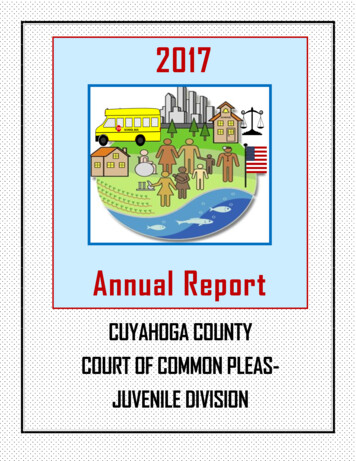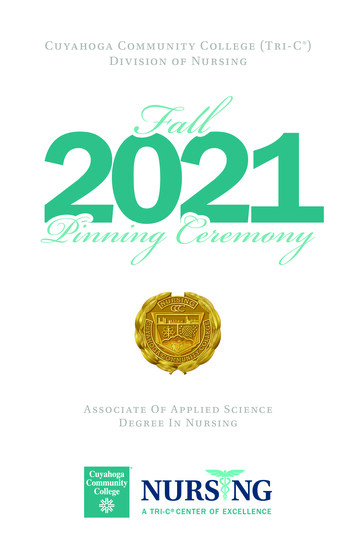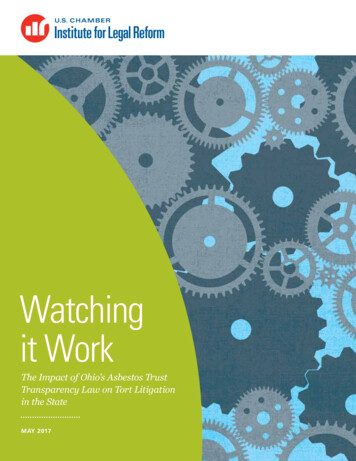
Transcription
2017Annual ReportCUYAHOGA COUNTYCOURT OF COMMON PLEASJUVENILE DIVISION
2TABLE OF CONTENTSTABLE OF CONTENTS Pages 2-32017 JUDGES, COURT ADMINISTRATOR & Page 4MISSION STATEMENTOPEN LETTER Pages 5-7OFFICE LOCATIONS Pages 8-11DETENTION SERVICESPages 12-17Detention ServicesPage 12PopulationPage 12Housing UnitsPage 12Educational ServicesPage 12Medical ServicesPage 13Mental Health ServicesPage 13Staff TrainingPage 13Trauma Training and ServicesPage 14Booking Process for Cleveland Police DistrictsPage 14Volunteer ServicesPages 15-17Editor Mary J. Davidson
3TABLE OF CONTENTSCOURT ADMINISTRATION DIVISIONPages 18-24Court Administration DivisionPage 18Probation InvestigationPage 18Probation SupervisionPage 18Probation Support ServicesPage 18Ohio Youth Assessment System (OYAS)Page 19Effective Practice in Community Supervision (EPICS)Page 19Motivational Interviewing (MI)Page 19Specialized DocketsPage 20Community Service/Restitution ProgramPage 20Multi-Systemic Therapy Program (MST)Page 21Placement AftercarePage 21Community Based Intervention Center (CBIC)Page 22Programming, Training and Quality AssurancePage 22Juvenile Detention Alternatives Initiative (JDAI)Pages 23-24Diagnostic ClinicPage 24LEGAL DIVISIONPages 25-27Legal DivisionPage 25Intake and Mediation UnitPage 25Clerk’s OfficePage 25Information Services (IS)Page 26Human ResourcesPage 26Fiscal Resources and Contract ManagementPage 262017 Local Fund ExpendituresPage 27STATISTICS DIRECTORY & STATISTICSPages 28-43
42017JUDGES, COURT ADMINISTRATOR & MISSION STATEMENTJUDGESAlison L. Floyd, Patrick F. Corrigan andAdministrative Judge Kristin W. Sweeney(Seated from left to right)Thomas F. O’Malley, Denise N. Rini and Michael J. Ryan(Standing from left to right )COURT ADMINISTRATORTerease Z. NeffMISSION STATEMENTTo Administer justice, rehabilitate juveniles, support and strengthen families,and promote public safety.
5OPEN LETTERCOURT OF COMMON PLEASJUVENILE COURT DIVISIONCOUNTY OF CUYAHOGA9300 Quincy AvenueCLEVELAND, OHIO 44106(216) 443-8400FAX: (216) 348-4039OHIO RELAY SERVICE 711KRISTIN W. SWEENEYADMINISTRATIVE JUDGETEREASE Z. NEFFCOURT ADMINISTRATORJUDGESPATRICK F. CORRIGANALISON L. FLOYDTHOMAS F. O’MALLEYMICHAEL J. RYANDENISE N. RINIThe Citizens of Cuyahoga CountyThe Honorable Maureen O’ConnorChief Justice, The Supreme Court of OhioArmond BudishCuyahoga County ExecutiveDan BradyPresident, Cuyahoga County CouncilHarvey J. ReedDirector, Ohio Department of Youth ServicesGreetings:2017 was an eventful year for the juvenile court. The issues that took up most of 2017 were 1) the union contract negotiationswhich included the compensation and classification study, 2) the detention center and 3) the biennial budget process.During January and February, the juvenile court and the union went through a fact finding process in an attempt to resolve theissues that were preventing an agreement on the new contract. During this time, the Court was working hard to find the fundsthat would make enacting the Classification and Compensation Study palatable to County Council and the County Executive.County Council approved implementation of the pay equity study based upon the National Center for State Court study Councilpaid for. The point was to equalize juvenile court salaries with those in the general division in order to reduce turnover. It wasalso intended to move people off of public assistance who worked for the Court as the majority of employees helped by the unioncontract and the study had been making between 23,000.00 and 32,000.00.
6OPEN LETTERThe juvenile court identified significant savings and revenue enhancements that may equal 5 million. The Court took painstakingsteps to comb each index code to get to a bare minimum budget. This number includes utilizing the Court’s special revenue fundswhich will be greatly reduced come year 2019. No stone was left unturned in an effort to improve court services for the childrenand families served while making the best use of county tax dollars. The 2016 budget for the juvenile court was cut by nearly 4%.In 2017, the budget was cut again about 6%. And for the 2018, the budget was cut by over 6%.Many structural changes were made that allowed the Court to free up funds to fund the compensation study with on-goingfinancial support from the County Council. The Court is working hard to make numerous cuts and to increase revenues for the2018-2019 biennium without compromising public safety. The judges agreed to a “soft” cap on the number of residents eachjudge could have in the Detention Center at any given time (25 residents per judge/magistrate not counting any resident whomay be tried as an adult). The judges agreed to end the contract with an outside vendor and move mediation to the IntakeDepartment. This decision has proven to be a financial savings for the Court and successful mediation agreements haveincreased. They agreed to a reformatting of Home Detention. The juvenile court now uses GPS equipment from the Sheriff’sDepartment, and with new technology the number of Home Detention officers decreased from 21 to 13 with acorresponding reduction in mileage.The court diagnostic clinic limited the use of contracted psychologists and hired full time staff members.This change was made after a yearlong study with Case Western Reserve University, the Department of Children and FamilyServices, the Alcohol, Drug, and Mental Health Services Board and the Board of Developmental Disabilities.This should drastically increase the efficiency of the clinic and improve services. Over the long run, this will result in costsavings as kids move through detention faster, and the Court is able to identify and divert more kids out of the system or intomore appropriate treatment services.In order to divert more youth out of the detention center and to improve outcomes for youth and families,the following new programs were implemented:The Community Based Intervention Center (CBIC), formerly known as the CBT Day Reporting program. For youth aged 14 or olderwho have a moderate to high risk of re-offending, and are on either home detention or probation. The program usesCognitive-Behavioral Interventions to allow youth to obtain skills to improve problem solving, develop long-term goalsand improve relationships with both peers and authority figures.High Fidelity Wrap Around is run by Ohio Guidestone and serves as an alternative to detention for youth with home detentionviolations. The program provides a comprehensive mental health assessment, clinical case management, and a family driven,strength-focused plan developed with a team approach.Beech Brook Respite and Therapeutic Foster Homes are for youth charged with domestic violence who need immediate respiteand would otherwise be in the detention center. Youth participating in this program are able to attend their home schools andwill have access to case management services with a wraparound model. The time spent in foster care will allow families to havea cooling off period while service providers and system navigators link families to necessary treatment services.
7OPEN LETTERBehavioral Diversion and Education (BDE) was in collaboration with the Court Intake Department, the Cleveland Rape CrisisCenter, the Prosecutor’s Office, the Public Defender’s Office, the GAL project, Guidestone, and Abraxas. This innovative newprogram is to identify and divert children thirteen and younger who have committed a sex offense upon a sibling or familymember. It is a voluntary program that is designed to create a safe space for the child to get the treatment and education theyneed, while recognizing the needs and safety of the victim. By diverting these cases out of the adversarial set up of thecourtroom, it is hoped that the family can receive treatment and counseling much more quickly and that the parents and childrenare able to acknowledge and safely resolve the issues that brought the family to the attention of the authorities.The opioid crisis and an increase in the number of children placed in foster care have also impacted the juvenile court. Thenumber of abuse, neglect, and dependency cases filed between 2013 and 2017 increased by 143%. In 2013, 1,216 of these caseswere filed. By 2017, there were 2,956 such cases filed. The magistrates hearing these cases report seeing an adult care giver/parent/guardian overdose death each week. As a result of increased and increasing custody caseloads, the dockets for the childprotection and private custody cases were divided and three new magistrates were hired to hear the private custody dockets.Finally, regarding the detention center, the juvenile court has been collaborating with the sheriff, the prosecutor, the countyexecutive, county council and the state juvenile prison system to improve the facility over the long haul.There was a particular incident last summer that caused an internal investigation. As a result of that investigation, the Courtasked for two outside groups to review our facility and our policies and procedures. The Court wanted outsiders who would becompletely objective. The Court specifically asked the sheriffs to review the facility because they are experienced in workingwith high risk populations, they could start immediately with no security adjustments, and they were able to conduct theassessment at no added cost to the Court. The leadership of the Portage/Geauga County Detention Facility also reviewed ourpolicies and procedures.The overall theme of these reviews was that there are leadership and cultural issues that will need to be addressed over a longterm and with constant readjustments. We began implementing those recommendations immediately and are continuing to workin this area.Along with the report of our achievements, I hereby submit, in compliance with Ohio Revised Code Sections 2151.18 and 2151.71,the 2017 Annual Report of the Cuyahoga County Juvenile Court regarding the number and kinds of cases coming before it, theirdispositions and other data pertaining to the work of the Court.Sincerely,Kristin W. Sweeney, Administrative Judge
8OFFICE LOCATIONSCOURT LOCATIONSMAIN COURTCuyahoga County Juvenile Justice Center9300 Quincy AvenueCleveland, Ohio 44106(216) 443-8400DETENTION CENTERCuyahoga County Juvenile Justice Center9300 Quincy AvenueCleveland, Ohio 44106(216) 443-3300METZENBAUM BUILDING3343 Community College AvenueCleveland, Ohio 44115(216) 443-3452
9INTAKE & DIVERSION OFFICE LOCATIONSCUYAHOGA COUNTYJUVENILE JUSTICE CENTER9300 Quincy AvenueCleveland, Ohio 44106(216) 443-8428All Intake Officer Bypass cases, Consent to Marry Applications,Certifications and Centralized Case Distribution.Court Unruly Project Coordinator, Cleveland Police DepartmentDistricts 1-5, Steelyard Commons & 3rd District downtown store security,Positive Education Program referrals, Cleveland Lakefront State Park,Cuyahoga County Division of Children & Family Services, ClevelandMetropolitan School District – Board of Education Cases, Sheriff’s Department,Mayfield Village, Euclid, East Cleveland, Metro Health,Case Western Reserve University, Waiver of Parental Notification, and Utilities.The following Law Enforcement Agencies:Norfolk/Southern & Conrail Railroad,Regional Transit Authority,Cleveland Metropolitan Housing Authority,Cleveland State University Police Department,Cuyahoga Community College Police Department-file with the Intake & Diversion Department and/orthe Juvenile Division of the Prosecutor’s Office.
10INTAKE & DIVERSION OFFICE LOCATIONSWEST SIDELakewood Office12650 Detroit Avenue, Lakewood, Ohio 44107 (216) 518-3332; (216) 521-2216 (fax)Areas Served: Lakewood, Bay Village, Fairview Park, North Olmsted, Rocky River, Westlake, Metro Parks,Olmsted Falls, Olmsted Township, Brook Park, Suburban Boards of Education, and Citizens.Southwest Office5361 Pearl Road, Parma, Ohio 44129 (216) 443-5381; (216) 749-2031 (fax)Areas Served: Linndale, Brooklyn, Brooklyn Hts., North Royalton, Parma, Parma Hts., Seven Hills, Broadview Hts.,Berea, Middleburg Hts., Strongsville, Suburban Boards of Education, and Citizens.EAST SIDEGarfield Office5555 Turney Road, Garfield Hts., Ohio 44125 (216) 518-3332; (216) 518-3334 (fax)Areas Served: Brecksville, Independence, Garfield Hts., Maple Hts., Valley View, Walton Hills, Garfield Post-OSHP,Ohio Dept. of Liquor Control, Division of Ohio State Highway Patrol, Gates MillsSuburban Boards of Education, and Citizens.East Cleveland/University Circle Office11811 Shaker Blvd. 4th Floor, Cleveland, Ohio 44106 (216) 698-7364; (216) 443-8064 (fax)Areas Served: Cleveland Clinic, Cleveland Hts., Bratenahl, University Circle, South Euclid, Euclid Store Security,Lyndhurst, Richmond Hts., Suburban Boards of Education, and Citizens.Southeast Office21100 Southgate Pkwy Suite #3, Maple Hts., Ohio 44137 (216) 663-6583; (216) 663-2351 (fax)Areas Served: Beachwood, Bedford, Bedford Hts., Bentleyville, Highland Hills, Highland Hts., Mayfield Hts.,Moreland Hills, Oakwood, Pepper Pike, Shaker Hts., University Hts., Woodmere, Warrensville Hts., Glenwillow,Solon, Orange, Chagrin Falls and TWP., North Randall, Hunting Valley,Suburban Boards of Education,and Citizens.
11PROBATION OFFICE LOCATIONSCENTRAL INVESTIGATIONS 9300 Quincy Avenue, Cleveland, Ohio 44106(216) 443-3573; (216) 698-2714 (fax)COMMUNITY SERVICE 9300 Quincy Avenue, Cleveland, Ohio 44106(216) 698-4727; (216) 443-3494 (fax)COMMUNITY BASED INTERVENTION CENTER 3343 Community College Avenue, Cleveland, Ohio 44115(216) 443-3131; (216) 443-8046 (fax)EAST CLEVELAND/UNIVERSITY CIRCLE Regional 3 & 4 11811 Shaker Boulevard 3rd Floor, Cleveland, Ohio 44120Regional 3: (216) 698-4554; (216) 443-8035 (fax)Regional 4: (216) 443-5493; (216) 443-8046 (fax)GRANTS MANAGEMENT 9300 Quincy Avenue, Cleveland, Ohio 44106(216) 698-4791; (216) 443-8433 (fax)MULTI-SYSTEMIC THERAPY 3343 Community College Avenue, Cleveland, Ohio 44115(216) 443-5938; (216) 698-2053 (fax)NEAR WEST SUPERVISION 3343 Community Avenue, Cleveland, Ohio 44115(216) 698-2708; (216) 443-2185 (fax)PLACEMENT AFTER CARE UNIT 3343 Community College Avenue, Cleveland, Ohio 44115(216) 443-3107; (216) 698-2053 (fax)PROBATION SUPPORT SERVICES 9300 Quincy Avenue, Cleveland, Ohio 44106(216) 443-3538; (216) 443-3476 (fax)SCHOOL BASED LIAISONS 3343 Community College Avenue, Cleveland, Ohio 44115(216) 926-2808; (216) 698-2053 (fax)SOUTHEAST SUPERVISION 21100 Southgate Park Boulevard, Maple Heights, Ohio 44137(216) 443-5348; (216) 663-2351 (fax)SOUTHWEST SUPERVISION 5361 Pearl Road, Parma, Ohio 44129(216) 443-5379; (216) 749-2031 (fax)SPECIAL SERVICES INVESTIGATIONS 9300 Quincy Avenue, Cleveland, Ohio 44106(216) 348-4490; (216) 443-3494 (fax)SPECIALIZED DOCKETS 9300 Quincy Avenue, Cleveland., Ohio 44106(216) 698-4727; (216) 443-3494 (fax)PLACEMENT PLANNING 3343 Community College Avenue, Cleveland, Ohio 44115(216) 698-6578; (216) 698-2053 (fax)BEHAVIORAL HEALTH JUVENILE JUSTICE 3343 Community College Avenue, Cleveland, Ohio 44115(216) 443-3142; (216) 698-2053 (fax)
12DETENTION SERVICESDETENTION SERVICESDetention Services administers the care of all juveniles in the secure Detention continuum, including: the Detention Center,Shelter Care, and Home Detention. During the year 2017, the Detention Center had an average daily population of 164 juveniles,Shelter Care an average daily population of 25 juveniles, and Home Detention monitored an average caseload of 141 juveniles.POPULATIONAdmission screening staff use a race-and gender-neutral validated and age appropriate risk assessment instrument (DASI) todetermine the appropriate pre-dispositional placement or status necessary to accomplish the purposes of Detention(i.e., ensuring appearance in Court and preventing re-offending). Staff place youth eligible for Detention in the least restrictivealternative needed to accomplish those purposes (e.g., a non-secure setting, home supervision, home electronic monitoring).Admission is limited to the most serious offenders.Home Detention Officers can provide electronic monitoring surveillance 24 hours per day, so violations can be addressed as theyoccur. Technology now allows the electronic monitoring of juveniles who do not have telephones landline. The Juvenile Courtexpanded active GPS surveillance to all Home Detention clients, in order to track the whereabouts of designated juveniles in realtime.HOUSING UNITSIn the 5 Housing Units, there has been an expansion in programming to educate the residents and provide them with positivereinforcement. Newly admitted residents are provided a thorough orientation by their Social Worker, House Manager, andDetention Officers. The Social Worker provides information pertaining to Court-related Detention procedures. The HouseManager and Detention Officers provide information about the daily schedule. They are also given information about theBehavior Management program, Detention rules and sanctions.EDUCATIONAL SERVICESThe Downtown Education Center is located inside the Juvenile Detention Center and residents attend the school on site.The Cleveland Metropolitan School District provides a principal, daily operations administrator, chief secretary, an educationalaide and fourteen academic teachers. Residents are enrolled in academic classes that are age and grade appropriate.Each student’s complete academic records are requested from their “home school” and each student is placed on anindividualized academic plan leading to graduation. Records requested include but are not limited to: IEP, ETR, Transcript, andState Testing Scores. All academic gains by the individual student are documented on their transcript and they are sent to theirhome school via an Exit Report. The School administers the New Ohio State Test (OST) and the Ohio Graduation Test (OGT) forqualifying students. After completion of required credits and passing the needed testing by the State of Ohio, students are issuedtheir high school diploma. During the 2016-2017 school year, the Downtown Education Center had 1,183 unique (non-duplicated count) students issued 1,136.5 total credits had 12 graduates
13DETENTION SERVICESMEDICAL SERVICESThe Detention Center contracts with MetroHealth Systems to provide on-site, around the clock nursing services for residents.Staffing includes one Managing Registered Nurse, four other registered Nurses, four Licensed Practical Nurses, and one medicalsecretary. A physician or Nurse Practitioner is also on-site for four hours every weekday, excluding holidays, andphysicians are on-call when not on the premises.MetroHealth physicians complete a physical exam of all residents within seven days of admission. The unit has been participatingin the Ohio Department of Health’s Infertility Prevention Program since 2003, thereby saving the County substantial funds forSTD testing and treatment.Residents are assured of confidential, unrestricted access to medical care by way of staff referrals for emergency medicalneeds. Medications are dispensed to residents as prescribed. Special dietary needs due to allergies, pregnancy, etc., arecommunicated to the food service staff and to living unit staff. Dental and other specialty care is provided by MetroHealth andother community providers.MENTAL HEALTH SERVICESThe Alcohol, Drug Addiction, and Mental Health Services Board contracts with Applewood Centers to provide Mental HealthServices for Detention Center and Shelter Care residents. The newest model provides five independent, licensed Social Workerson-site forty hours each week and therapists are on-call after hours to assist with any mental health crisis. The therapists areproviding special training for all Detention Center staff. Psychiatrists are on-site eight hours each week and they also provideevaluation, counseling, psychotropic medication referrals, monitoring, grief counseling, and crisis intervention, along withreferrals for hospital admissions.The Massachusetts Youth Screening Instrument (MAYSI) was implemented in late 2015 as part of grant funding provided by theOhio Department of Youth Services. This screening device is self-administered by all youth approved for admission to theDetention Center before arriving on an assigned housing unit. This brief assessment measure is used to identify youths withpotential mental, emotional, or behavioral problems-including possible risk indicators such as suicidal behavior-prior to arrivingat their assigned housing unit.STAFF TRAININGAll Juvenile Detention employees and contracted staff receive annual mandatory Core Competency training that includesCardio-Pulmonary Resuscitation and Automatic External Defribulator, Standard First Aid, Blood-borne in Pathogens,Communicable Diseases, Emergency Response (suicide prevention and intervention), Para-Verbal and Verba De-Escalationtechniques, Subject Control Instruction for escorting and Unarmed Self-Defense, fire extinguisher use, and Prison RapeElimination Act (PREA)/Sexual Assault Sexual Abuse training. Staff who directly supervise residents receive a total of fortyhours annually, in accordance with American Correctional Association Accreditation standards. All newly hired direct servicestaff receive forty hours of pre-service orientation training and 120 hours of on-the-job training before assuming theirresponsibilities.
14DETENTION SERVICESTRAUMA TRAINING AND SERVICESRecognizing that detained youth experience trauma that can impact their behavior and cause them to act out in ways that arehard to understand and difficult to manage, Detention Center workers now receive training to recognize the signs of trauma inyouth and the ways staff can intervene for the best possible outcomes. Detention Center personnel will receive additionaltraining in self-care, as they witness and learn about traumatic events. Interventions in cooperation with Applewood Centers’Mental Health Services can be provided to the residents on an one-on-one basis.Studies show that this type of training and service can greatly reduce the number of room confinements and restraints andcan even create a safer and more comfortable environment for residents and staff.BOOKING PROCESS FOR CLEVELAND POLICE DISTRICTSThe Juvenile Court began the centralized booking of juveniles arrested by the Cleveland Police in 2016. The effort restructureshow alleged juvenile offenders arrested by the Cleveland Police are processed and booked after an arrest, something that willpermit officers to return to patrolling more quickly. Prior to the change in the process, the alleged juvenile offender wastransported from the scene of the offense to the local Cleveland Police District Headquarters. The alleged juvenile offender wasthen transported downtown to the Justice Center for booking at the Cleveland City Jail, where conditions are not appropriate forminors. If the determination was made that the alleged juvenile offender was to be detained, he or she was transported to theCuyahoga County Juvenile Court’s Detention Center. If the alleged juvenile offender was not to be detained, he or she wastransported home.All alleged juvenile offenders arrested by Cleveland Police are taken directly to the Juvenile Court Detention Center for booking.The alleged juvenile offenders who meet the Court’s admissions criteria are detained. Those who do not, are transported homefrom the Detention Center.This process: Restructures the booking process for alleged juvenile offenders, including alleged violent gang offenders; Separates alleged juvenile offenders from violent adult offenders-ending the process of exposing juveniles to adults in theJustice Center’s common booking area; Reduces the time alleged juvenile offenders are in police custody; Decreases unnecessary transportation by law enforcement; Enables Cleveland Police Officers to return to duty more quickly.
15DETENTION SERVICESVOLUNTEER SERVICESA variety of community volunteers provide programming in the areas of life and social skills. Substance abuse awareness,health education, creative writing, cooking, arts and crafts, anger management, job readiness, social emotional learning,tutoring and hands on activities for residents continue to be instrumental in their mental and emotional development.Community members, leaders and professionals, and athletes, give motivational presentations and entertainers present playsthroughout the year. Community organizations provide after-school tutoring to help residents improve their educationaldevelopment.Before volunteers and college interns can work with residents, they must be cleared through criminal background checks. SPACES art gallery featured original art work of CCJDC residents’ as part of their Art in the Community exhibit; CCJDCart collaboration made possible by through the NoVo FoundationART FORWARD - monthly art sessions (see photo below) facilitated by CWRU students to promote creativity and empathyto foster mutual learning and conversation TRIUMPH magazine sponsored motivational speakers program including a playwright, author and a radio talk show host Golden Ciphers Rites of Passage utilizes evident-based curriculums allowing youth to become active educated advocates intheir own life and communities Good Friday Worship Services co-sponsored by Elizabeth Baptist Church & Bethany Baptist Church Zion Pentecostal Church of Christ with support from True Freedom Ministries, Inc. provided baptism ceremonies forHouse 3 residentsAnnual Residents’ Christmas Dinner sponsored by Building Leadership, Academics & Service, Blessed Hope MissionaryBaptist Church, Elements of Internal Movement Non-Profit Organization 501(c)3, Faith Alliance Bible Church,Inner-City Church and Cynthia SmithAnnual Residents’ Thanksgiving Dinner sponsored by Cynthia Dorsey, M.D., mother of Michael Gong, co-founder,Carroll Ballers program focused on mentoring and character developmentResidents Game Day sponsored by Elizabeth Baptist Church
16DETENTION SERVICESVOLUNTEER SERVICES (CONTINUED) Visions Revealed, Inc. interactive workshops empower residents to identify goals and strategies for successful re-entryWriters in Residence program facilitated by John Carroll University students led creative writing sessions for artisticself-expression and constructive self-reflection Tours of the Cuyahoga County Juvenile Detention Center included Annual Sheriff’sDepartment Citizens Academy members and International visitors(see photo at right) from Australia, Indonesia, Netherlands, Pakistan, Tajikistan, andTurkey toured the CCJDC to examine community-based efforts designed to promotesafe, tolerant, and inclusive neighborhoods. They were here in Cleveland on theprogram “Change Makers: Promoting Community Resilience Against Radicalization andExtremism.” The project is sponsored by the U. S. Department of State through theInternational Visitor Leadership Program Higher Art Life led by David Ramsey provides acting lessons and teaches techniques through open paint sessions allowingfreedom to createPower Source, an evidence-based program for at-risk youth to discover the best in themselves through social emotionallearning orchestrated by John Carroll University students.Cleveland Treatment Center’s Project Safe and Recovery Resources offered HIV/AIDS Awareness, alcohol, tobacco,other drugs, gambling awareness, and community resources to aid in recovery Cleveland Orchestra Isabel Trautwein, Violinist and Jody Guinn, principal harpist of the Akron Symphony Orchestra(see photo below) and the Cleveland Opera performed a mini concert of French music and solo pieces by Bach and othercomposers Philemon Community Baptist Church donated basketballs for leisure activities Daniel R. Wasnick, Executive Director/ Founder, Keep Playing Cleveland initiated an equipment drive to provide CCJDC tofill our gymnasium storage room with much needed athletic equipment
17DETENTION SERVICESVOLUNTEER SERVICES (CONTINUED) Steve Richardson, Founder, Building Leadership Academics & Service (B.L.A.S.) and his volunteer team consisting oflicensed barbers & hair stylists provided haircuts for our male and female residents Cleveland Public Theatre's Education Department and the Cleveland YMCA's Y-Haven Program presented Golden,the 2017 CPT/Y-Haven Theatre Project (see photo below).The theatre piece based on the journeys of formerly homeless men and their quest toward recovery. Achieve 3000 a computer based intervention program throughout the nation sponsored a pizza party on November 15, 2017in the Detention Center School known as the Downtown Education Center (DEC) for all residents at their expense.Our school is recognized as being one of the highest achieving schools in Ohio and has numerous students (see photo below)who are in the top in Ohio, including the very top student! “The pizza party is to recognize our student’s effort andcooperation in the school environment along with promoting educational growth.
18COURT ADMINISTRATION DIVISIONCOURT ADMINISTRATION DIVISIONThe Court Administration Division consists of Probation Services, Operations, Programming, Training & Quality Assurance and theDiagnostic Clinic.PROBATION INVESTIGATIONProbation investigation is responsible for conducting an initial risk assessment called the Ohio Youth Assessment System (OYAS),which measures the youth’s risk level in addition to preparing a report for the jurist that includes previous charges, familyhistory, school performance, mental health, and substance abuse issues. Investigative Probation Officers also makerecommendations for various assessments to evaluate specific issues, such as substance abuse, mental health, and sexoffending behavior. The Investigative Probation Officer then writes a report detailing all of the collected information and presentsa carefully considered recommendation to the jurist that weighs the Court’s mission to both protect the community andrehabilitate offenders. The Probation Department has two investigative probation units: Central Probation Inv
Cuyahoga County Juvenile Justice Center 9300 Quincy Avenue Cleveland, Ohio 44106 (216) 443-8400 DETENTION CENTER Cuyahoga County Juvenile Justice Center 9300 Quincy Avenue Cleveland, Ohio 44106 (216) 443-3300 METZENBAUM BUILDING 3343 Community College Avenue Cleveland, Ohio 44115 (216) 443-3452










